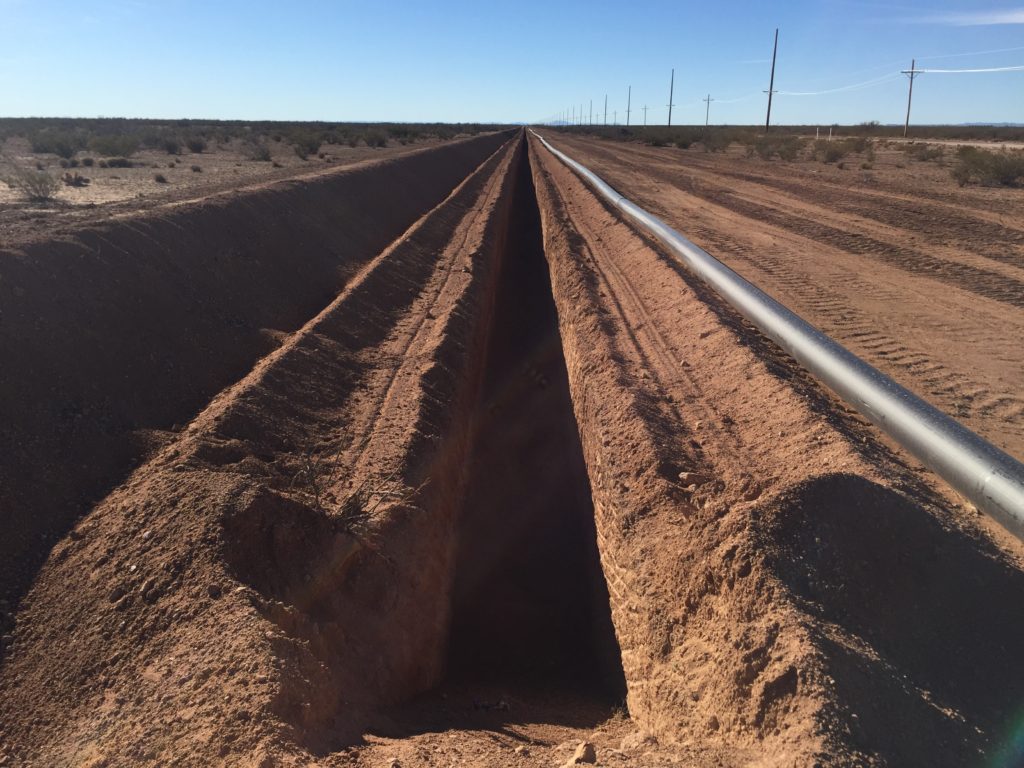
Negotiating Pipeline Easements: 13 Things You Need to Know
By: Raulie Irwin
When a pipeline representative contacts you to obtain a pipeline right-of-way across your property, you basically have two choices. You can refuse their offer or you can choose to negotiate. Understand that if you outright refuse their offer they will then file to condemn your property.
If you refuse the offer from a pipeline company and go to a condemnation hearing the only thing you can obtain is the money settlement. A condemnation hearing only deals with money. The three commissioners conducting the condemnation hearing cannot by law grant you anything but money. The only way to obtain any agreements and concessions from the pipeline company is to negotiate.
With the development of the oil and gas plays in Texas, our lands are being crisscrossed with pipelines delivering petroleum products to processing facilities. Sometimes several lines are being installed on the land owner’s property.
A pipeline easement is perhaps the most common easement a land owner has to deal with in these times. Most prior pipeline easements are perpetual and run with the title of the land. The unfortunate thing about these easements is that they allow for the installation of multiple pipelines lines. Many old easements have no limit as to how many lines can be placed in an existing easement.
A typical pipeline easement can be from fifty feet to one hundred feet wide. The permanent easement is generally less than the working easement. The working easement allows for a wider temporary access for the construction or laying of the pipeline. Once the pipeline is in place the permanent easement generally becomes fifty or sixty feet wide.

A list of thirteen helpful hints follows when negotiating a pipeline easement, either new or installation of an additional line.
THIRTEEN TIPS TO NEGOTIATING PIPELINE EASEMENTS:
1. Limit the term of the easement.
It maybe fifty years, but have a termination date. Allow for the pipeline company to renew the easement with additional payment when the initial term expires. State what is to take place at the end of the easement. Whether the pipeline is to be removed or not, needs to be decided at the beginning of the lease.
2. Be sure to limit the pipeline to one line and one line only.
Specify when the easement reverts back to the land owner and specify what constitutes abandonment of the easement.
3. Insert language that restricts the easement to the company you lease to.
Do not allow the pipeline company to sub-lease or allow other companies to use the easement with out compensation to the landowner and certainly without notifying you of the sale or assignment. You want to always know who owns the easement.
4. Determine if there are to be any pipes above the ground.
This is a surface lease and is worth more money. Be sure to limit the size of the surface easement and require that it be fenced off and kept clean and mowed.
5. The larger the diameter of the pipe, the deeper it needs to be.
Require that pipes be buried at least four feet deep and watch the construction contractor to make sure it is done. The ditch should be ‘double ditched’. The top soil should be placed on one side and put back in the trench last or on top. The clay is to be placed on the other side and goes back in the ditch first.
6. Require that the easement be kept clean and/or mowed at least once a year, maybe twice.
Specify when it will be done and how and that you be notified when the mowing contractor will be in your pasture.
7. Specify the restoration process the contractor will perform when finishing the pipeline and before leaving the job.
It’s important to document what condition your land should be restored to post construction. For example, should they reseed with native grasses? What should be the seeding rate?
8. Restrict the hours the contractor will begin work and finish work and what days they will not be allowed to work.
Pipeline and oil field work is generally seven days a week, twenty-four hours a day. All heavy equipment are required to have safety alarms or backup bells and they can be heard a long ways off.
9. Restrict the access route to the pipeline and specify that all personnel will stay within the easement.
Anyone found off the easement area or width should be guilty of trespassing. Allow for your own inspector or watchman and insure that the contractor will abide by their directions.
10. Address environmental responsibilities and have appropriate indemnifications.
Require that Skid-O-Cans be kept on the job and serviced regularly. State the consequences if someone doesn’t use the skid-o-can. Make sure they pick up their trash daily or otherwise a wind will come up and you will have plastic bags all over your pasture. Livestock just love to eat the bags and then you have a very sick animal.
11. State what is going to happen when you find beer cans and /or bottles or other trash on your property.
Independent trucking contractors will deliver the pipe and they do not care what your rules state or the agreement says. When you find the trash or beer bottles, the guilty party will be long gone. Therefore, that right-of-way agent you dealt with should be required to be on the job every day the contractor works on your property. Otherwise, when you have a problem the agent will be 500 miles away on another assignment.
12. State that a violation of the terms of the lease will allow the landowner to terminate the easement at any time.
Include the land owner’s right to recover damages for violations of the terms and from any activity not permitted or agreed upon.
13. State the use of the surface the land owner will have during the term of the easement.
Require that the land owner be notified immediately of a change in ownership of the pipeline. You can require that your own inspector, supervisor or guard be present during the construction of the pipeline on your own property.
Make these conditions actual parts of the lease, not just covenants, and have consequences.
We have a much more in depth article on Eminent Domain. Check out Eminent Domain for Pipelines & Highways
If you need additional information or assistance, contact Raulie Irwin at 361-645-2115.
About the Author:
Raulie Irwin has been a general appraiser for 34 years, a real estate broker for 44 years and a right-of-way agent for 30 years. Raulie graduated from Texas A & M University in 1972, with a Bachelor’s Degree in Building Construction. He and his wife, Georgia, live on a ranch called Critterville at Weesatche, in Goliad County, Texas. Raulie has been providing real estate services to land owners all over Texas for the past thirty-five years.
